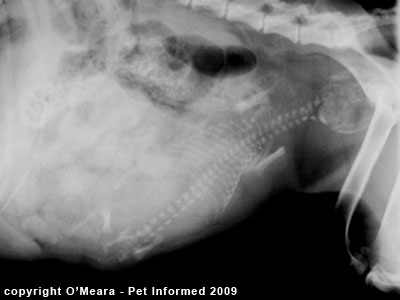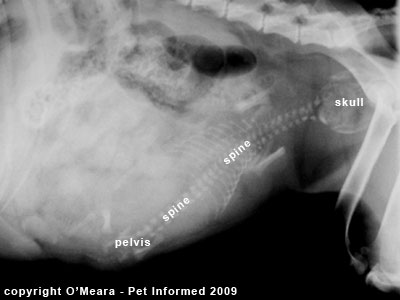|
Is My Cat Pregnant? How To Diagnose Cat Pregnancy.
This page contains detailed information about how to diagnose pregnancy in cats, including: feline pregnancy signs, cat pregnancy ultrasounds (cat pregnancy scan), abdominal radiography and certain other cat pregnancy tests. Information on how to determine numbers of kittens present (litter size), sizes of kittens present and assess the basic health of the kittens in utero is also included. Is My Cat Pregnant? How To Diagnose Pregnancy in Cats - Contents: 1) Diagnosing pregnancy in cats: 1a) Your cat's medical and environmental history - does it fit with a likelihood of your cat being pregnant? 1b) Are there supporting feline pregnancy signs? 1c) Abdominal palpation - can the vet feel a cat's belly to tell if the cat is pregnant? 1d) Abdominal ultrasound (cat pregnancy scan) - the best indicator of feline pregnancy. 1e) Abdominal radiography (taking x-rays). 1f) Relaxin assays - a blood test for feline pregnancy. 2) Other uses for cat pregnancy testing diagnostics: 2a) How many kittens is she expecting? Ways to determine cat litter size prior to birth. 2b) Is the cat pregnancy healthy, viable and normal? 2c) Kitten sizes. 2d) Kitten positions. 1) Diagnosing pregnancy in cats. This section contains information on the various tests and diagnostic techniques available for the detection of pregnancy in cats. Information on the feline 'background' histories and on the clinical signs and symptoms that may be supportive of a cat pregnancy diagnosis are all included, as is information on the specific cat pregnancy tests that can be performed in order to confirm that diagnosis . 1a) Your cat's medical and environmental background history - does it fit with a likelihood of your cat being pregnant? There are certain historical facts (events in your cat's history) and background details that may or may not support a likelihood of your cat being pregnant. Some of these are very obvious, some less so. This list is just a small sample of some of the historical points and background information that you should think about when trying to decide if your female cat could be pregnant or not. This checklist is just a guide and is certainly not all-inclusive (I am sure you could think of a number of additional points to think about). Is the cat in question actually female? Incorrect sexing of pet cats occurs all the time and your Jessie may in fact actually be a Jerry. If your cat is a female, then she could be pregnant. If the cat is a male, then he won't be. Simple. The long and the short of it is: make sure that your cat is actually sexed correctly (see our great cat sexing pages) before you book the cat in for a feline pregnancy test. 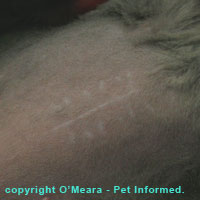 Is the cat entire?
Is the cat entire? Spayed cats can not fall pregnant. If you have had the cat in question since it was a kitten, then you should have a fair idea of whether she has been desexed or not. If the cat came to you as an older animal of unknown surgical history, then there is a chance that she may have been previously desexed. Check your cat's ear (generally the left ear, but check both ears to be certain) for a desexing tattoo and/or get your vet to check your cat's belly for a spay scar. The image on the right shows a pale grey spay scar on a cat's belly (you can even see the scar-holes running alongside the spay line where the skin sutures were placed). If the cat is spayed then she should not be pregnant. Has the cat reached puberty? Female cats generally start breeding from 6-9 months of age, however cats as young as 4-5 months have been known to fall pregnant on occasion. If your cat is about 5 months old or more, then there is a chance that she could be pregnant. Has the cat had any possible access to male cats? If your female cat is a completely (and I mean completely) indoors-living animal with no possible access to other cats, then there is little chance of her falling pregnant. Cats that live or at least spend time outside are much more likely to become impregnated by male cats in the area. Be aware, however, that indoors-only means indoors only. Some people think that an "indoor cat" is a cat that spends 'most of its time' indoors. It's not. If the cat in question has any free, unsupervised access to the outside world, even if it is only for thirty minutes a day or via a come-and-go cat-door, then the cat is not strictly an indoors cat and there is every chance of her becoming pregnant. A fertile mating can take place in seconds and so a female cat that is outside, unwatched, for thirty minutes could easily be mated by a male cat in that time and fall pregnant. Equally be aware of the risk of cat doors as useful access points for entire tom cats. It is not that unusual for tom cats (particularly domesticated toms) to wander into a female cat's house through a cat door (cat-flap). The mating could take place inside of your home without your own female cat ever leaving the indoors environment. Also be aware of the incredible lengths some cats will go to in order to procreate with the opposite sex. Male cats will scale the "seemingly-unscalable" walls of roof-less cat runs in order to access female cats in heat. Female cats have been known to push their bottoms up against open-mesh wire cat runs and cat aviaries in order to mate with male cats on the outside. The cats essentially mate through the wire and the female cat becomes pregnant (an seemingly 'immaculate conception') without ever having left the cat enclosure. Has the female cat escaped recently? This is an extension of the "access to male cats" point, above. If your female cat has recently escaped from your house or yard or cat-run into the local environment (i.e. within the last 2 months), then she could certainly have been mated and now be pregnant. Was your female cat in heat recently (within the last 2 months)? The female cat generally displays the signs of being "in heat" (feline estrus signs) just before the onset of pregnancy. The estrus period (in heat period) is the time that the female cat will 'stand' to be mated by a male cat. Being the time of mating, it is, consequently, the time that cat pregnancy is most likely to begin. If you noticed your cat showing signs of being in heat or "in-season" just before she became fat and "pregnant looking" then there is every chance that she could truly be pregnant. Were there male cats lurking around your house and yard within the last 2 months? Male cats are expert at detecting the scent of a female cat in heat even if we ourselves, as pet owners, can not yet detect the signs. A female cat in heat will attract male cats to her in the hope of copulation. If you noticed a number of male cats lurking around your house or garden just before your female cat became fat and "pregnant looking" then there is every chance that your cat could truly be pregnant. Was the cat deliberately mated? Obviously, if you intentionally had your female cat mated, then there is every likelihood that she could now be pregnant. This is the situation seen with most cat breeders - they place the male cat in with the female cat and so witness the matings that could result in the pregnancy. Was the female cat seen to mate? Sometimes pet cat owners will chance upon seeing their female cat copulating with a male cat in the house or yard. The cat owner may arrive just in time to spot the mating itself (the brief seconds of male cat mounting and thrusting, whilst the female cat poses on her chest and belly beneath him), but, generally, most owners will only see and/or hear the after effect of the mating - when the female cat screams and attacks the male cat as he withdraws from the copulation. This scream and attack will often be very short lived, after which the female cat will roll on her back affectionately (termed a post-coital or post-copulatory roll). If your female cat is observed to yowl and attack a male cat (generally a larger bodied cat) in your yard, particularly if this attack seems to only be half-serious in intention and/or it is followed up with a roll onto the back, then there is every likelihood that the female cat in question has just been mated. Did the female cat recently become involved in a cat fight (she might have developed an abscess)? Because of the violence inherent in feline mating and breeding activities, it is not uncommon for a female cat to suffer from mild bites and scratches as a direct consequence of her copulation activities. An entire female cat who comes back from an outdoors adventure with signs of being in a cat fight (bites, wounds and scratches) could well have been mated. Some cats may even go on to develop nasty cat fight abscesses on their bodies, which will need treatment by a vet. 1b) Are there supporting feline pregnancy signs? Most cat owners start querying whether or not their feline friend could be pregnant after observing various external signs (usually a "fat belly" or "pot belly") that "fit with" a diagnosis of cat pregnancy. These feline pregnancy signs include:
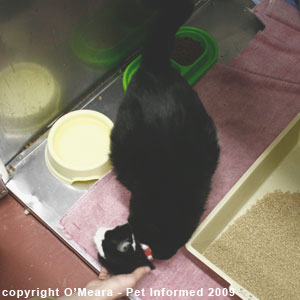 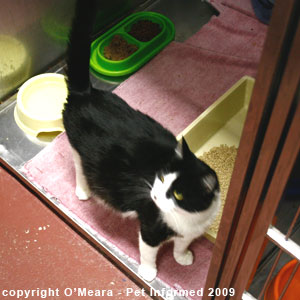 Feline pregnancy signs pictures 1 and 2: These are pictures of a heavily pregnant cat in the later stages of cat pregnancy (she has since gone on to have her litter). Her abdomen is very round and distended and hangs almost pendulously below her spine. 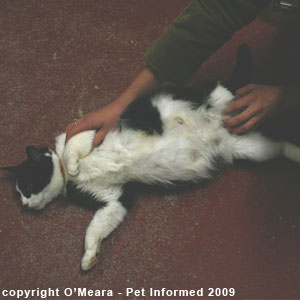 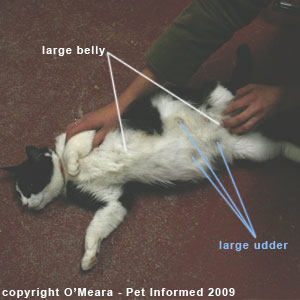 Cat pregnancy signs pictures 3 and 4: These are pictures of a heavily pregnant cat in the later stages of cat pregnancy (she has since gone on to have her litter). She is laying on her back and her swollen belly expands outwards around her. Her abdomen is very round and distended. Her udder (mammary gland chain) is now well developed with large, well-developed nipples and enlargement of the mammary blood vessels. No milk was yet being produced by this cat. 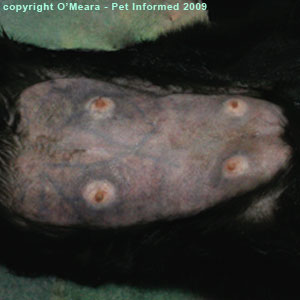 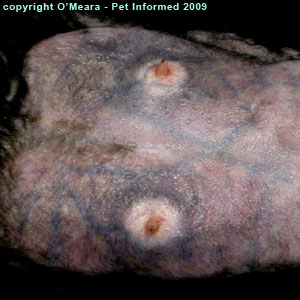 Feline pregnancy signs picture 5: This is an image of the enlarged udder of a pregnant cat (the cat's fur has been shaved from the belly for ease of visualisation). The mammary glands are massively enlarged, as are the blood vessels (blue lines criss-crossing the skin) supplying them. Feline pregnancy signs picture 6: This is a close up image of the enlarged udder of a pregnant cat. The blood vessels (dark blue-purple lines criss-crossing the skin) supplying the engorged mammary glands are very dilated and large. 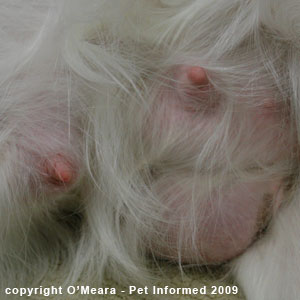 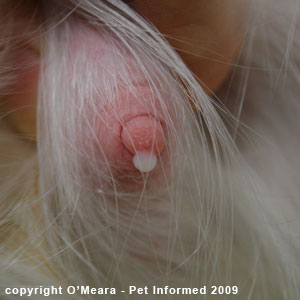 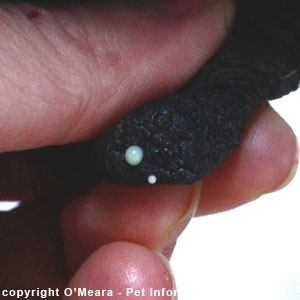 Canine pregnancy signs picture 7: This is a close up image of the udder of a dog about to give birth. The udder was large, sagging and pendulous with large, milk-filled nipples. Similar mammary gland enlargement will also be seen in the pregnant cat at the end of feline gestation (refer to cat pregnancy picture 5). Dog pregnancy signs picture 8: This is a close up image of the udder of a dog about to give birth. The udder was large, sagging and pendulous with large, milk-filled nipples. When the mammary gland was squeezed, milk beaded on the tips of the nipples. This particular mammary gland revealed opaque, white milk (see image), but the other glands revealed a honey-like, pale-yellow, straw-coloured milk called "colostrum" (the 'first milk'). The presence of colostrum indicates the end of pregnancy and that labor is soon to commence. Dog pregnancy signs picture 9: This is a close up image of the udder of a different dog about to give birth. The udder was large, sagging and pendulous with large, milk-filled nipples. When the mammary gland was expressed, milk beaded on the tips of the nipples. This particular mammary gland revealed a honey-like, watery, pale-yellow, straw-coloured milk called "colostrum" (the first milk). The presence of colostrum indicates that labor is soon to commence. The colostrum appears a bit greenish in this image because colostrum is not fully opaque like true milk is and the black hue of the nipple behind it is showing through the colostrum fluid, artificially darkening the colour. 1c) Abdominal palpation - can the vet feel a cat's belly to tell if the cat is pregnant? Experienced veterinarians who regularly palpate the abdomens of pregnant cats can often get a rough idea of whether or not a cat is pregnant and/or just how advanced a cat pregnancy is by feeling (palpating) the cat's abdomen. In performing an abdominal palpation, the vet is trying to feel for the uterine swellings that accompany a feline pregnancy (early to mid pregnancy) and/or the size and presence of the kittens, should they be at a stage that is possible to feel (generally, kittens are only able to be clearly palpated in the very later stages of cat pregnancy). Generally, the first, spherical, uterine swellings that are associated with fetal development in the uterus can be palpated at around 17-25 days of gestation. The advantages of abdominal palpation as a way of diagnosing cat pregnancy:
The disadvantages of abdominal palpation as a way of diagnosing cat pregnancy:
1d) Abdominal ultrasound (cat pregnancy scan) - the best indicator of feline pregnancy. Abdominal ultrasound is a very useful way of diagnosing pregnancy in cats (I would say that it is the way of diagnosing cat pregnancy that is most favoured by veterinarians). The veterinarian places the ultrasound-wave emitting probe on the animal's abdomen and uses the reflection of the ultrasound waves bouncing off the various tissue surfaces to detect the fetal kittens and the surrounding uterine fluids and placental membranes present in the cat's abdomen. The surrounding placental fluids, in particular, are very obvious on ultrasound scan and can usually be spotted quite early on in the cat pregnancy (even when the fetal kittens themselves are only very tiny). Embryonic kittens position themselves along the uterine horns of the pregnant cat around 13-14 days after conception and they can usually be detected on ultrasound as discrete spherical swellings from about 11-15 days of gestation. It must be noted, however, that to diagnose pregnancy this early on in cat gestation does generally require a very good ultrasound machine and a considerably experienced ultrasonographer. In my experience (having only rarely had access to the kinds of million-dollar ultrasound machines that are rarely ever found in most normal vet clinics), more reliable pregnancy diagnosis is generally achieved by ultrasound machine if the feline pregnancy is around 3 weeks old or more. The detection of a fetal heart beat is normally only possible from about 22 days of gestation, so, if the heartbeat can be seen, you know that the kitten must have a fetal age of at least 3 weeks and that it is, for now, a living, presumably-viable kitten. 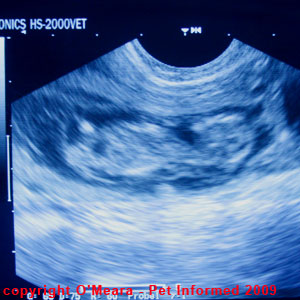 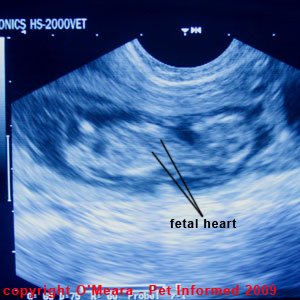 Dog and cat pregnancy images 10 and 11: These are images of a developing puppy foetus as seen on an ultrasound pregnancy scan (note - foetal kittens look very similar to foetal puppies on ultrasound). The fetus floats suspended within a liquid cavity of uterine fluid and fetal membranes (the black spaces surrounding the floating foetus). In the second image (11), I have labeled the two-sided foetal heart. The heart was rapidly beating away when this photo was taken, confirming that the dog foetus was indeed alive and healthy. In addition to the diagnosis of cat pregnancy, pregnancy ultrasound scans can also provide us with additional information about the fetal kittens. Abdominal ultrasound can be used to estimate the kittens' fetal age and the stage of cat pregnancy (how long there is to go before the kittens will be born). Ultrasound scans can be used to evaluate the health and viability of the kittens present. It can also be used to estimate the numbers of fetal kittens present (though it is not so accurate as radiography for this purpose). Fetal aging using ultrasound: The crown-rump lengths (the distance from the head to the bottom of the pelvis) of the fetal kittens are often able to be detected on ultrasound scan. As kittens grow in utero, their bodies become longer (i.e. the crown-rump length increases). The crown-rump length of the kittens' bodies can help the ultrasonographer to determine the approximate age of the fetuses present in utero (i.e. the stage of cat pregnancy). Fetal lengths as they are used for the purposes of fetal kitten aging and cat gestation staging are described in our great "stages of feline pregnancy" page. The main problem with using fetal kitten crown-rump-length estimations as a means of fetal aging is the fact that the fetal kittens do not always position themselves neatly in a straight line. They curl up into balls, mould themselves around other nearby kittens or abdominal organs and, in the later stages of cat pregnancy, they move about. This can make it very difficult to determine their body lengths with any accuracy. For this reason, many ultrasonographers choose to measure the cross-sectional diameter of the kittens' heads and chests, rather than their crown-rump lengths, as a more accurate marker of fetal age. For example, kittens with a head diameter of 1.6cm have about 3 weeks of uterine growth left to go before they are born. In the second and third trimesters of pregnancy (i.e. a gestation age of 3 weeks onwards), each subsequent week of fetal growth, either way, seems to involve a change of approximately 0.3cm in the head diameter (e.g. a kitten with a head diameter of 1.3cm has about 4 weeks to go; a kitten with a head diameter of 1.9cm has about 2 weeks to go, a kitten with a head diameter of 2.2cm has about a week to go and so on). The fetal heart beat also provides us with another element of fetal aging. A fetal heart beat can normally only be detected from 22-25 days of cat gestation age and, so, the detection of a heartbeat tells us that the kitten must be at least 22 days old, developmentally. Subjectively, I have found that the presence or absence of surrounding placental fluids also helps to indicate the gestation age of the fetal kittens. Kittens that are within about 2 weeks of being born (very late pregnancy) tend to have little to no surrounding fluid present in the amniotic and allantoic sacs encasing their bodies. It seems that, in dogs and cats, this surrounding fluid is reabsorbed back into the mother's body in the very last weeks of pregnancy. Hence the very late stage fetal kitten does not appear to have a halo of black fluid (black regions on ultrasound) surrounding it. In mid-gestation, there is generally a lot of fluid surrounding the foetal kittens. Please note: Kitten sizes and uterine-swelling sizes can vary somewhat with the number of kittens present in the litter. Larger litters tend to have smaller kittens and smaller uterine swellings than might be expected for the stage of cat pregnancy that they are at. This can add an element of inaccuracy to the use of fetal crown-rump lengths and fetal head and chest diameters as a means of gauging fetal age and the stage of cat pregnancy. Fetal viability using ultrasound: There are several ways that ultrasound scan can be used in order to assess the health and viability of a cat pregnancy. Fetal heartbeat - The presence of a heartbeat tells us that the fetus being examined is alive. In most normal, healthy, non-stressed fetal kittens and puppies, the normal fetal heart-rate is above 200 beats per minute. When a fetus is about to be born, its body comes under stress and its heart rate will often drop to levels of just above or below the 200bpm mark. Many veterinarians who engage in elective Caesarian section surgeries for breeders will use this reduction in fetal heart rate as one of the indicators that birth is about to begin and that it is time to perform the surgery. If a fetus is undergoing considerable fetal distress of the kind that could result in death (e.g. fetal infection; hypoxia or oxygen starvation due to early placental separation, prolonged dystocia [trouble or difficultly giving birth] or an unwell mother and so on) the fetal heart rate will often drop to considerably less than 200 beats per minute. Emergency Caesarian section (C-section) to save the lives of the fetal kittens (or puppies) is indicated if the fetal heart rate drops to below 180 bpm and keeps falling. The movements of the fetuses - Living fetal kittens move around. You will often see them roll over or kick out their legs as the ultrasound watches them. The 'clearness' of the surrounding fetal fluids - The placental fluids surrounding a developing fetus should be clear (perfectly black) in a healthy pregnancy. If the fluids become cloudy (grey-coloured on ultrasound) or develop "floaties" (bits of debris floating through the fluid), then it is likely that the fetus is unhealthy. It might be infected (e.g. bacterial infection), in the process of being aborted (i.e. miscarriage) or it might even be dead and breaking down (degenerating). The 'clearness' of the fetal image - When a fetus is alive and viable, its body outline and its internal organ features are very distinctly and clearly visible on ultrasound scan. You will generally be able to see a clear heart, lungs, ribs, liver and skull in a live fetus. When the fetus is dying or deceased, its internal organ structures break down and are no longer clearly visible. Indistinct or blurry internal and external structures tell us that a fetus is not likely to be viable. Fetal number using ultrasound: It is difficult to accurately assess fetal numbers using ultrasound, except in the very early stages of cat pregnancy. In later stages, the fetuses curl around one another and can not all be seen at the one time. This makes counting them very difficult as only a cross-section of an individual fetus is seen at any one time. The advantages of abdominal ultrasound as a way of diagnosing cat pregnancy:
The disadvantages of abdominal ultrasound as a way of diagnosing cat pregnancy:
 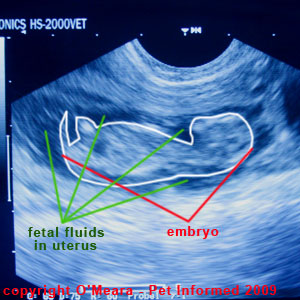
Dog pregnancy images 12 and 13: These are images of a puppy dog fetus as seen on an ultrasound scan (note - fetal kittens look very similar to fetal puppies on ultrasound). The fetus floats suspended within a cavity of uterine fluid and fetal membranes (the dark regions surrounding the fetus, which are marked out as "fluid" on the second image - 13). I have outlined the dog fetus (labeled incorrectly as 'embryo') in white in the second image and you should be able to recognise the animal's shape as being kitten-like or puppy-like: the head and muzzle are visible (right of image), as is the tail and back leg (left of image). The crown-rump length is the distance from the head to the base of the tail. 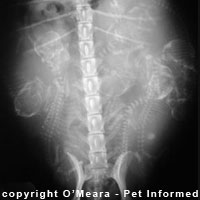 1e) Abdominal radiography (taking x-rays):
1e) Abdominal radiography (taking x-rays):The bones of fetal kittens become mineralized (calcified) at around day 40-45 of cat pregnancy. Radiographs taken of pregnant cats after day 45 of gestation will usually reveal whether or not the animal is pregnant because the radiographs will generally clearly reveal the skeletons of the kittens. Before this 40-45 day stage of cat gestation, pregnancy diagnosis using radiography is generally inaccurate. The vet may get a subjective impression of an enlarged uterus, but this does not necessarily indicate that the animal is pregnant (other disease conditions besides pregnancy can produce enlargement of the uterus). Fetal aging using radiography: If radiographs taken of the pregnant cat reveal the skeletons of the kittens, then we can say that the fetal age of those kittens is at least 40-45 days or more. The radiographs can also be used to get an estimate of the fetal crown-rump length of the kittens, thereby providing more clue as to the age of the kittens in the uterus. Take a look at the image opposite (right). It is an abdominal radiograph of a pregnant dog (the same image would apply to a pregnant cat, however). You can see several tiny skeletons within this abdominal image. These are the calcified skeletons of the fetal puppies. This tells us that the fetal age of the unborn animals is at least 40-45 days. Fetal number and litter size using radiography: Radiography is the best indicator of fetal number (litter size). By counting the skulls and spines of the fetal kittens, the vet can usually determine how many fetal kittens are present in the cat's belly. Fetal size and position using radiography: In the very end stages of gestation, just prior to birth, the vet can assess the size of the fetal kittens' heads and shoulders relative to the size (width) of the female cat's birth canal (pelvic canal) and, from this comparison, determine whether or not birth is likely to occur with ease or with difficulty. This comparison is not so important in pregnant cats, where kitten sizes tend to be relatively uniform, but it is very important in dogs, particularly if the mother is small in breed and the father's size is unknown (e.g. a pomeranian female mated to a bulldog male is almost certain to have problems giving birth if the size of his bulldog head is anything to go by!). The advantages of abdominal radiography as a way of diagnosing cat pregnancy:
The disadvantages of abdominal radiography as a way of diagnosing cat pregnancy:
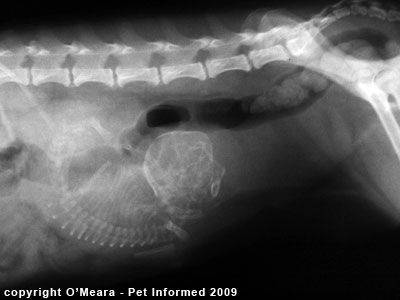 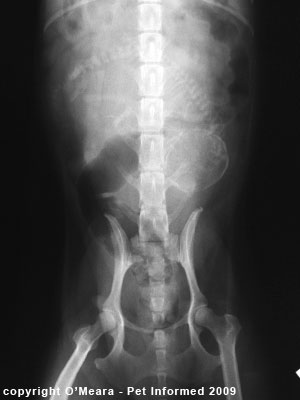 Cat pregnancy image 14: This is a radiograph of a pregnant dog (a cat pregnancy would appear similar), taken using a lateral view. A single dog fetus (see the skeleton in the centre-left region of the picture) is visible in this image. Cat pregnancy image 15: This is a radiograph image of the same pregnant dog (a cat pregnancy would appear similar), taken using a ventral-dorsal view. A single fetus (see the tiny skeleton in the mid abdomen) is visible in this image. 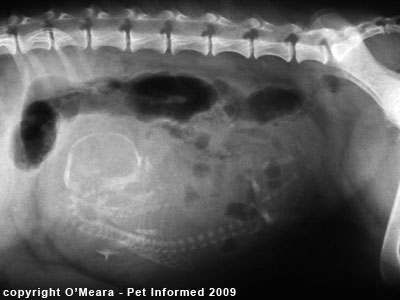 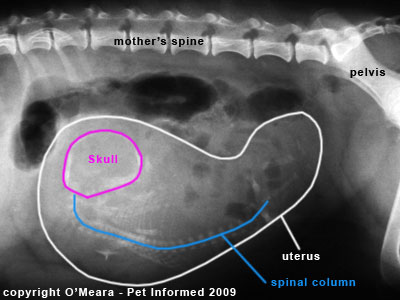 Cat pregnancy images 16 and 17: This is a picture of a pregnant dog as seen on radiography. A pregnant cat would appear very similar on x-ray film. A single fetus (see the skeleton in the middle of the picture) is visible in this image. I have labeled the skull and spine of the fetus in the second image (17) to make these structures more obvious. The enlarged uterus bearing the fetus is outlined in white. 1f) Relaxin assays - a blood test for cat pregnancy: Relaxin is a hormone that is secreted by the placental unit of the pregnant uterus after about the 20-25 day stage of cat pregnancy. It is "pregnancy specific" (the presence of Relaxin tells you that the animal is pregnant) and its presence indicates that the kitten fetuses are at least 20-25 days old (fetal age). Please note that Relaxin assays can be difficult to access. Many labs do not perform this test. If you can source a lab that will run the test, however, this can be very useful. 2a) How many kittens is she expecting? Ways to determine cat litter size prior to birth. Pet owners, especially cat breeders, often want to know how many kittens to expect. This is for several reasons: So that they will know if there is a problem with the birth - If five kittens are expected and only three arrive, then there is a problem with the birth. The two remaining kittens might have died and so have not been born normally or they might be trapped somewhere in the uterus (e.g. in case of a uterine torsion or twist) or the pregnant cat's birth canal. So that they will know when the birth has finished - Once the cat labor process has finished, the kittens should all be feeding off the mother and the female cat should now be relaxed and contented-looking. No further kittens are expected and the watchful owner knows that s/he can now relax in the knowledge that the labor went normally and that the cat should no longer have any need to be rushed off to the vet for reasons of birthing difficulty. So that they will know how big an area (e.g. whelping box) to prepare for the birth - A large litter needs a larger space to be born into. So that they will know how many people they can line up to sell kittens to - Cat breeders need to know prospective litter sizes so that their kitten-buying clients can be lined up to take the kittens once they have been weaned. There is no point promising seven people a kitten if only six kittens are going to be born! Knowing litter sizes can help breeders to establish their waiting lists for kitten buyers. So that they will know whether or not a "surrogate mother" or "bottle feeding" will be needed - Postnatal kitten mortality is greatly increased when larger numbers of kittens are competing for limited numbers of teats on a female cat's udder. A female cat only has a certain number of nipples (typically about 8 nipples) and greater than eight kittens in a litter will mean that competition for these limited milk reservoirs is heated. The larger, more vigorous kittens will tend to dominate and the weaker, runtier kittens will be pushed aside, often to their deaths if a cat breeder is not vigilant in ensuring that they all get enough milk. A cat owner who knows to expect a large litter can ensure that milk supplementation equipment is on stand-by to help the weaker kittens or that a surrogate mother (a recently whelped cat with a smaller litter size of kittens already feeding off her) is sourced who will be able to take on some of newborn kittens in addition to her own small litter. Female cats are often quite tolerant of taking on surrogate offspring that are not their own, provided that they already have their own litter and provided that the new additions are similar in size and age to the already pre-existent litter. 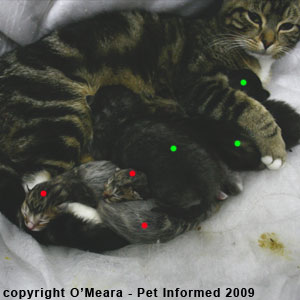 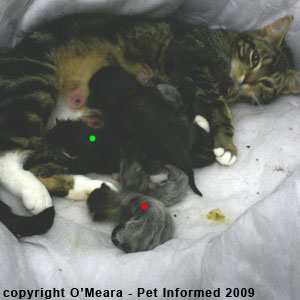 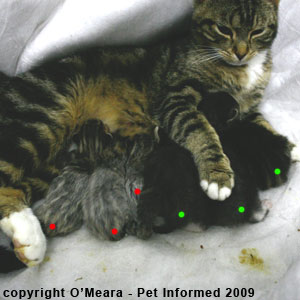 Cat pregnancy diagnosis pictures 18, 19 and 20: This is a female cat with three kittens of her own (the three larger kittens, labeled with green dots) and three surrogate kittens from another mother who, presumably, could not provide enough milk for all of her young (the smaller, newer kittens, labeled with red dots). The mother cat seems quite content to look after all of the extra mouths. You'll notice in image 20 that when the kittens have all aligned themselves for feeding, the three original kittens take up positions along the front group of teats, leaving the rear teats for the smaller fosters. The front teats are the teats of choice (more milk) and the small foster kittens could never hope to compete with the larger, stronger littermates for these choice positions. How to determine litter sizes (fetal numbers): Radiography is the best indicator of fetal number (litter size). By counting the skulls and spines (see images below) of the fetal kittens, the vet can usually determine how many kittens are present in the pregnant cat's belly. It is difficult to accurately assess fetal numbers using ultrasound, except in the very early stages of cat pregnancy. In the later stages of cat pregnancy, the crowded kitten fetuses curl around one another and can not all be seen at the one time. This makes counting them very difficult as only a cross-section of an individual fetus is seen at any one time. 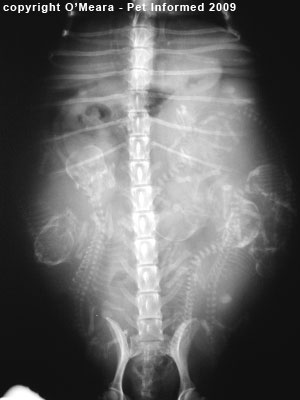 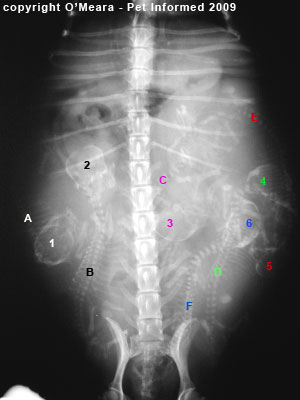 Cat pregnancy diagnosis pictures 21 and 22: This is an image of a pregnant dog, showing how radiography can be used in order to assess fetal numbers. The vet can count the fetal kittens or puppies by counting their skulls (the round, crash-helmet-like structures that have been labelled with numbers in image 22). Alternatively, the vet can count the number of fetal kittens or puppies by counting their spines (the long, jointed structures that have been labelled with letters in image 22). I have attempted to match skulls to spines by labeling the skulls with their corresponding spines in the same colours. This dog has 6 puppies inside. 2b) Is the cat pregnancy healthy and normal? If the fetal kittens grow normally, free of genetic defects, and they remain undamaged by such insults to the uterine environment as: infection, oxygen starvation, overcrowding, premature placental separation, stress (both maternal and fetal), toxins (e.g. drugs, poisons, medications) and trauma, they should go to term without incident. It is possible for fetal health to be checked-up-on and monitored throughout the cat pregnancy using ultrasound scanning (just like occurs in human pregnancies). Although regular ultrasound check-ups are seldom performed in order to monitor the progress of the average cat pregnancy, such intense monitoring of the health and progression of a feline pregnancy can be important in female cats that have a previous history of abortion and miscarriage of their litters (failure to go to term). This is particularly so if the cat in question is a valuable breeder. Performing weekly ultrasounds can not only tell the breeder whether the kittens are viable, but, should fetal death or miscarriage occur, they can tell the owner the exact moment in the gestation when the failure of pregnancy happened. This can provide important clues as to the cause of the cat pregnancy failure. There are several ways that ultrasound can be used in order to assess the health and viability of a cat pregnancy: Fetal heartbeat - The presence of a heartbeat tells us that the fetus being examined is alive. In most normal, healthy, non-stressed fetal kittens and puppies, the normal fetal heart-rate is above 200 beats per minute. When a fetus is about to be born, its body comes under stress and its heart rate will often drop to levels of just above or below the 200bpm mark. Many veterinarians who engage in elective Caesarian section surgeries for breeders will use this reduction in fetal heart rate as one of the indicators that birth is about to begin and that it is time to perform the surgery. If a fetus is undergoing considerable fetal distress of the kind that could result in death (e.g. fetal infection; hypoxia or oxygen starvation due to early placental separation, prolonged dystocia [trouble or difficultly giving birth] or an unwell mother and so on) the fetal heart rate will often drop to considerably less than 200 beats per minute. Emergency Caesarian section (C-section) to save the lives of the fetal kittens (or puppies) is indicated if the fetal heart rate drops to below 180 bpm and keeps falling. The movements of the fetuses - Living fetal kittens move around. You will often see them roll over or kick out their legs as the ultrasound watches them. The 'clearness' of the surrounding fetal fluids - The placental fluids surrounding a developing fetus should be clear (perfectly black) in a healthy pregnancy. If the fluids become cloudy (grey-coloured on ultrasound) or develop "floaties" (bits of debris floating through the fluid), then it is likely that the fetus is unhealthy. It might be infected (e.g. bacterial infection), in the process of being aborted (i.e. miscarriage) or it might even be dead and breaking down (degenerating). The 'clearness' of the fetal image - When a fetus is alive and viable, its body outline and its internal organ features are very distinctly and clearly visible on ultrasound scan. You will generally be able to see a clear heart, lungs, ribs, liver and skull in a live fetus. When the fetus is dying or deceased, its internal organ structures break down and are no longer clearly visible. Indistinct or blurry internal and external structures tell us that a fetus is not likely to be viable. The fetal sizes with respect to the stage of cat pregnancy and point of gestation - Just like in human obstetrics, the size of the fetal kittens in the uterus can be an important marker of whether the pregnancy is advancing healthily and normally. Kittens that are undersize for their stage of gestation (e.g. a kitten that has a crown-rump length of 5cm at 6 weeks gestation, when it should be 7cm long at this stage of cat pregnancy) may indicate that there is a problem with the cat pregnancy. The kittens may be overcrowded (i.e. a large litter of kittens will often be smaller in fetal size due to overcrowding and competition for nutrients); the mother cat may not be getting the right nutrition; the kitten/s might have a congenital defect; there might be a uterine defect (e.g. a defect limiting the supply of nutrients getting to the fetuses); there might be an infection and so on. Please note that in order for fetal sizing to be used to determine the health of a cat pregnancy, the date of pregnancy conception needs to be accurate. Knowing the mating dates and/or the date that the first progesterone surge occurred is essential if accurate kitten aging and sizing is to be of use down the track. Sizing as a means of establishing the health of a cat pregnancy is of no use if the date of pregnancy conception is unknown. Radiography is of little value in determining the viability and health of a feline pregnancy, although the presence of the calcified fetal skeletons does at least tell us that the cat pregnancy managed to make it to the 40-45 day gestation mark. If the cat pregnancy is progressing normally and the fetal kittens are still alive, then their bodies should have a nicely structured skeleton shape on radiography (i.e. a skull on top of a neat line of spine bones with the ribcage, foreleg bones and pelvic bones in their proper places). If the fetal bones seem to be oddly piled up and overlapping each other (e.g. bones in a pile) on x-ray, then it is likely that the fetus has died some time after the 40-45 day bone-mineralisation mark. In this event, the fetal tissues break down and absorb back into the mother's body and the fetal bones, which do not absorb, remain in the uterus in a bony stack. 2c) Kitten sizes in feline pregnancy. Cat breeders and owners of pregnant pet cats often want to know fetal kitten sizes for a variety of reasons:
Using ultrasound in order to assess the size of the fetal kittens: The crown-rump lengths (the distance from the head to the bottom of the pelvis) of the fetal kittens are often able to be detected on ultrasound scan. As kittens grow in utero, their bodies become longer (i.e. the crown-rump length increases). The crown-rump length of the kittens' bodies can help the ultrasonographer to determine the approximate age of the fetuses present in utero (i.e. the stage of cat pregnancy). Fetal lengths as they are used for the purposes of fetal kitten aging and cat gestation staging are described in our great "stages of feline pregnancy" page.
1) Verstegen J, Feline Reproduction. In Ettinger SJ, Feldman EC, editors: Textbook of Veterinary
Internal Medicine, Sydney, 2000, WB Saunders Company. 2) Feline Reproduction. In Feldman EC and Nelson RW: Canine and Feline Endocrinology and Reproduction, 2nd ed. Sydney, 1996, WB Saunders Company. 3) The Pelvis and Reproductive Organs of the Carnivores. In Dyce KM, Sack WO, Wensing CJG editors: Textbook of Veterinary
Anatomy, 2nd ed. Sydney, 1996, WB Saunders Company. 4) Johnson CA False Pregnancy, Disorders of Pregnancy, Parturition and the Postpartum Period. In Nelson RW, Couto CG, editors: Small Animal Internal Medicine, Sydney, 1998, Mosby. |
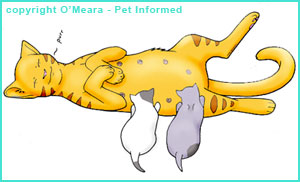 Unless a mature female cat is spayed early (prior to attaining puberty) or kept housed in a strictly indoors environment well away from male cats, it is very likely that she will become pregnant at some stage in her life. Cats are rampant breeders and it is not uncommon for cat owners to bring "suddenly-fat," entire, female cats into the veterinary clinic for reasons of pregnancy diagnosis. In these situations, the cat breeding is generally accidental, not deliberate (i.e. the cat pregnancy is, at best, "unexpected" and, at worst, "unwanted") and the cats are usually presented to the vet clinic in an advanced state of feline gestation.
Unless a mature female cat is spayed early (prior to attaining puberty) or kept housed in a strictly indoors environment well away from male cats, it is very likely that she will become pregnant at some stage in her life. Cats are rampant breeders and it is not uncommon for cat owners to bring "suddenly-fat," entire, female cats into the veterinary clinic for reasons of pregnancy diagnosis. In these situations, the cat breeding is generally accidental, not deliberate (i.e. the cat pregnancy is, at best, "unexpected" and, at worst, "unwanted") and the cats are usually presented to the vet clinic in an advanced state of feline gestation.
